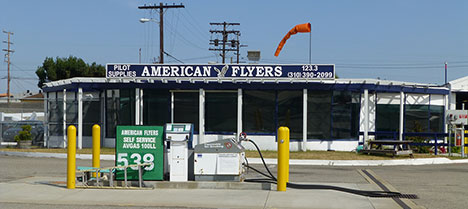
April 27, 2017
After almost 50 years and thousands of pilots trained, American Flyers is pulling up stakes at Southern California’s historic Santa Monica Municipal Airport (SMO). American Flyers closed its doors at SMO on April 15, consolidating its western operations at its facilities in Scottsdale, AZ and Texas.
Like all the other aviation businesses at SMO, American Flyers has been operating on a month-to-month lease for almost two years, making it next to impossible for the company – a Part 141 flight school that operates at five airports around the country – to attract financing for capital investments, such as a new building, for its Santa Monica school.
“ We’ve been in the flight training business for 77 years, at many airports, and at every other location they love having us there,” said Jill Cole, president of American Flyers. “ Unfortunately, it didn’t make any sense for us to stay at Santa Monica with the city trying to do everything it could to run us off the field. The daily fight, which went on for years, is not worth it.”
According to Cole, American Flyers contacted the city several years in advance of its lease expiration to start negotiations for a renewal. “ All they did was continually delay,” she said.
NBAA has worked closely with American Flyers and other SMO businesses in the decades-long legal battle to keep the airport open, despite the city’s repeated attempts to restrict aviation operations. Prior to the unprecedented settlement agreement between the FAA and the city, announced in late January, Santa Monica was required to keep the airport open in perpetuity, pursuant to a 1948 instrument of transfer. The recent settlement agreement requires the airfield to remain open only through Dec. 31, 2028, and allows the city to immediately begin to reduce the length of SMO’s sole runway.
“The eviction notices we received last year were a stab in the back, but the settlement agreement was the final straw,” said Cole.
According to Alex Gertsen, NBAA’s director of airports and ground infrastructure, the association is currently challenging the agreement in federal court. “NBAA and the other stakeholders have also requested a stay against the FAA, as well as an injunction against the city, to prevent further actions to reduce the runway length while the appeals court conducts its review,” said Gertsen. Read more about NBAA’s legal challenge to the settlement agreement.
Cole said that the handwriting has been on the wall for years. Implementation of $15 landing fees for single-engine piston aircraft some years ago was “ clearly an effort to drive people away from the airport,” she said, noting that her school was forced to pass some of the extra cost on to its students. The landing fee also discouraged many pilots from flying into SMO.
American Flyers – which at the request of the city many years ago also served as an FBO, at one time operating the airport’s self-serve fuel pumps, a fuel truck, tie-downs and some hangar space – has seen a dramatic decline in pilots served, especially international students.
“Potential students were going online and seeing news articles that the airport is closing,” said Cole. FBO revenues were also way down.
American Flyers worked with the city to transition the fueling operation and avoid interruption in the availability of avgas. Aeroplex/Aerolease Group will temporarily manage and operate the self-service fueling facility at SMO until the city conducts a search for a permanent operator.
“Most pilots obtain their wings at general aviation airports like Santa Monica, and business aviation and the airlines rely on flight schools like American Flyers to build our aviation workforce,” said Gertsen. “General aviation airports also serve as an inspiration to future generations and provide a valuable link to the community. As a flight school and FBO, American Flyers was that critical link in the chain at SMO.”


 International Business Aviation Council Ltd.
International Business Aviation Council Ltd.